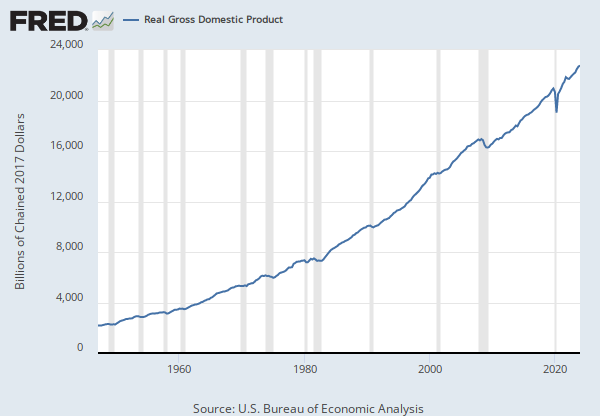Federal Reserve Economic Data
Data in this graph are copyrighted. Please review the copyright information in the series notes before sharing.
Notes
Source: U.S. Congressional Budget Office
Release: Budget and Economic Outlook
Units: Percent, Not Seasonally Adjusted
Frequency: Quarterly
Notes:
Starting with the July, 2021 report: An Update to the Budget and Economic Outlook: 2021 to 2031, this series was renamed from "Natural Rate of Unemployment (Long-Term)" to "Noncyclical Rate of Unemployment".
The natural rate of unemployment (NAIRU) is the rate of unemployment arising from all sources except fluctuations in aggregate demand. Estimates of potential GDP are based on the long-term natural rate. (CBO did not make explicit adjustments to the short-term natural rate for structural factors before the recent downturn.) The short-term natural rate incorporates structural factors that are temporarily boosting the natural rate beginning in 2008. The short-term natural rate is used to gauge the amount of current and projected slack in labor markets, which is a key input into CBO's projections of inflation.
Suggested Citation:
U.S. Congressional Budget Office, Noncyclical Rate of Unemployment [NROU], retrieved from FRED, Federal Reserve Bank of St. Louis; https://fred.stlouisfed.org/series/NROU, .
Source: U.S. Congressional Budget Office
Release: Budget and Economic Outlook
Units: Percent, Not Seasonally Adjusted
Frequency: Quarterly
Notes:
This series last appeared in the February, 2021 report: An Overview of the Economic Outlook: 2021 to 2031. The suggested substitute for this series is "Noncyclical Rate of Unemployment" (NROU), formerly called "Natural Rate of Unemployment (Long-Term)."
The natural rate of unemployment (NAIRU) is the rate of unemployment arising from all sources except fluctuations in aggregate demand. Estimates of potential GDP are based on the long-term natural rate. (CBO did not make explicit adjustments to the short-term natural rate for structural factors before the recent downturn.) The short-term natural rate incorporates structural factors that are temporarily boosting the natural rate beginning in 2008. The short-term natural rate is used to gauge the amount of current and projected slack in labor markets, which is a key input into CBO's projections of inflation.
Suggested Citation:
U.S. Congressional Budget Office, Natural Rate of Unemployment (Short-Term) (DISCONTINUED) [NROUST], retrieved from FRED, Federal Reserve Bank of St. Louis; https://fred.stlouisfed.org/series/NROUST, .
Release Tables
Permalink/Embed
modal open, choose link customization options
Select automatic updates to the data or a static time frame. All data are subject to revision.


















